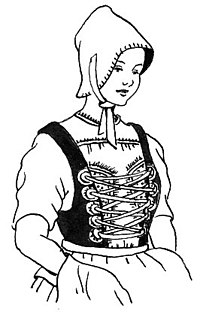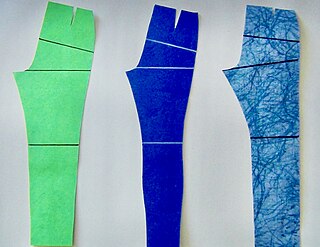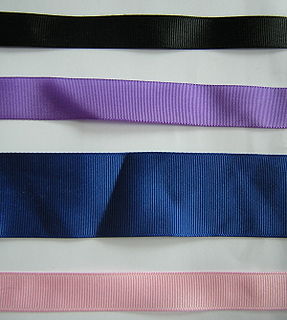
In sewing, the armscye is the armhole, the fabric edge to which the sleeve is sewn. The length of the armscye is the total length of this edge; the width is the distance across the hole at the widest point.

In sewing, the armscye is the armhole, the fabric edge to which the sleeve is sewn. The length of the armscye is the total length of this edge; the width is the distance across the hole at the widest point.
Multiple theories for the etymology of "armscye" have been proposed.
The scholarly etymology has the origin as "arm" + "scye."[ citation needed ] The first documented use of "scye" in print is by Jamieson (1825) Suppl.: "sey," a Scots and Ulster dialect word (written also scy, sci, si, sie, sy in glossaries) meaning ‘the opening of a gown, etc., into which the sleeve is inserted; [1] [2] the part of the dress between the armpit and the chest (of obscure etymology, and sometimes confused with "scythe" due to similarly curved shapes).
A more fanciful folk etymology is as follows. Because the expression "arm's eye" was used in some older sewing texts (e.g. "Gynametry," published in 1887 [3] ) it is conjectured that in poor prints the apostrophe and the crossbar of the lower case "e" were indistinct, and the neologism "armscye" was created by readers who concatenated the orphaned fragments "arm" and "s" with the corrupt "cye". According to this undocumented theory, until the beginning of the 20th century writers favoured the original term or at least a more logical variation (e.g. "armeye" in The Perfect Dressmaking System, published in 1914 [4] ), but as self-proclaimed experts copied each other, the term "armscye" eventually became widely enough used by home sewers to gain general acceptance.
The latter theory is clearly contradicted by evidence (discussed above) that the term "scye" was already in use at least as early as 1825. Therefore, the erroneous folk analysis was not in the direction from "arm's eye" to "armcye", but rather from the original "armcye" to "arm's eye" (which made more sense to modern English speakers, with a later adjustment more recently back to the correct "armscye").[ citation needed ]

A surcoat or surcote is an outer garment that was commonly worn in the Middle Ages by soldiers. It was worn over armor to show insignia and help identify what side the soldier was on. In the battlefield the surcoat was also helpful with keeping the sun off the soldier and their armor which helped prevent heat stroke and heat exhaustion. The name derives from French meaning "over the coat", a long, loose, often sleeveless coat reaching down to the feet.

A sewing machine is a machine used to sew fabric and materials together with thread. Sewing machines were invented during the first Industrial Revolution to decrease the amount of manual sewing work performed in clothing companies. Since the invention of the first sewing machine, generally considered to have been the work of Englishman Thomas Saint in 1790, the sewing machine has greatly improved the efficiency and productivity of the clothing industry.

The academic dress of Durham University has many similarities with that of other older British universities such as Oxford and Cambridge. Most colleges of Durham University insist on gowns being worn on formal occasions, including matriculation and formal halls (dinners); exceptions are Van Mildert, St Cuthbert's Society, Collingwood, Stephenson, St Aidans, and The College of St Hild and St Bede. Some colleges also insist on their being worn to Junior Common Room meetings, and they are often seen in college chapels. At formal halls, only gowns are worn and doctors normally wear their undress gowns; for more ceremonial occasions full-dress gowns and hoods are worn by graduates. Until 1990, the General Regulations of university 'recommended' the wearing of gowns by members of the university when attending divine service at the Cathedral – but this is now left to individual choice apart from at certain services. Gowns are also customarily worn to meetings of the university Senate by members of that body.
The academic dress of the former University of Wales was designed for the first graduations in 1893, and has as its main identifying feature a faculty colour scheme involving 'shot silks'.

Shortbread or shortie is a traditional Scottish biscuit usually made from one part white sugar, two parts butter, and three to four parts plain wheat flour. Unlike many other biscuits and baked goods, shortbread does not contain any leavening, such as baking powder or baking soda. Shortbread is widely associated with Christmas and Hogmanay festivities in Scotland, and some Scottish brands are exported around the world.

A blouse is a loose-fitting upper garment that was worn by workmen, peasants, artists, women, and children. It is typically gathered at the waist or hips so that it hangs loosely ("blouses") over the wearer's body. Today, the word most commonly refers to a girl's or woman's dress shirt. It can also refer to a man's shirt if it is a loose-fitting style, though it rarely is. Traditionally, the term has been used to refer to a shirt which blouses out or has an unmistakably feminine appearance.

A bodice is an article of clothing traditionally for women and girls, covering the torso from the neck to the waist. The term typically refers to a specific type of upper garment common in Europe during the 16th to the 18th century, or to the upper portion of a modern dress to distinguish it from the skirt and sleeves. The name bodice is etymologically an odd plural spelling of "body" and comes from an older garment called a pair of bodies.

A doublet is a man's snug-fitting jacket that is shaped and fitted to the man's body. The garment was worn in Spain, and spread to the rest of Western Europe, from the late Middle Ages up to the mid-17th century. The doublet was hip length or waist length and worn over the shirt or drawers. Until the end of the 15th century, the doublet was usually worn under another layer of clothing such as a gown, mantle, overtunic or jerkin when in public.

Proportion is a central principle of architectural theory and an important connection between mathematics and art. It is the visual effect of the relationships of the various objects and spaces that make up a structure to one another and to the whole. These relationships are often governed by multiples of a standard unit of length known as a "module".

In sewing and fashion design, a pattern is the template from which the parts of a garment are traced onto woven or knitted fabrics before being cut out and assembled. Patterns are usually made of paper, and are sometimes made of sturdier materials like paperboard or cardboard if they need to be more robust to withstand repeated use. The process of making or cutting patterns is sometimes compounded to the one-word Patternmaking, but it can also be written pattern(-)making or pattern cutting.

A dress shirt, button shirt, button-front, button-front shirt, or button-up shirt, is a garment with a collar and a full-length opening at the front, which is fastened using buttons or shirt studs. A button-down or button-down shirt is a dress shirt with a button-down collar – a collar having the ends fastened to the shirt with buttons.

A sleeveless shirt is a shirt manufactured without sleeves, or whose sleeves have been cut off. Depending on the style, they can be worn as undershirts, worn by athletes in sports such as track and field and triathlon, or as casual wear.
Sweater design is a specialization of fashion design in which knitted sweaters are designed to fulfill certain aesthetic, functional and commercial criteria. The designer typically considers factors such as the insulating power of the sweater ; the fashion of its colors, patterns, silhouette and style lines, particularly the neckline and waistline; the convenience and practicality of its cut; and in commercial design, the cost of its production and the profitability of its price point. Sweater designs are often published in books and knitting magazines. Sweater design is an old art, but continues to attract new designers such as Nicky Epstein and Meg Swansen.

In sewing and dressmaking, a ruffle, frill, or furbelow is a strip of fabric, lace or ribbon tightly gathered or pleated on one edge and applied to a garment, bedding, or other textile as a form of trimming.

Grosgrain is a type of fabric or ribbon defined by the fact that its weft is heavier than its warp, creating prominent transverse ribs. Grosgrain is a plain weave corded fabric, with heavier cords than poplin but lighter than faille, and is known for being a firm, close-woven, fine-corded fabric. Grosgrain has a dull appearance, with little luster in comparison to many fabric weaves, such as satin, often used for ribbons; however, it is comparatively very strong. Grosgrain fabric is most commonly available in black, but grosgrain ribbon comes in a large variety of colors and patterns. The ribbon is very similar to Petersham ribbon in its appearance, but it does not have the ability to follow the curves of a surface or edge the way that the latter does.

Princess seams are long rounded seams sewn into women's blouses or shirts to add shaping or a tailored fit to closely follow a woman's shape. They are sewn into the front and/or back of a shirt, and extend from the waist up to the arms. Princess seams are distinct from darts in that they form a continuous line and are a full seam. Darts, on the other hand, are folds sewn into the clothing to shape the resultant garment.

Cowichan knitting is a form of knitting characteristic of the Cowichan people of southeastern Vancouver Island, British Columbia. The distinctively patterned, heavy-knit Cowichan sweaters, popular among British Columbians and tourists, are produced using this method. Cowichan knitting is an acculturated art form, a combination of European textile techniques and Salish spinning and weaving methods. From this union, new tools, techniques and designs developed over the years.
Sewing is the craft of fastening or attaching objects using stitches made with needle and thread. Sewing is one of the oldest of the textile arts, arising in the Paleolithic Era. Although usually associated with clothing and household linens, sewing is used in a variety of crafts and industries, including shoemaking, upholstery, sailmaking, bookbinding and the manufacturing of some kinds of sporting goods. Sewing is the fundamental process underlying a variety of textile arts and crafts, including embroidery, tapestry, quilting, appliqué and patchwork.

In sewing, a seam is the join where two or more layers of fabric, leather, or other materials are held together with stitches. Prior to the invention of the sewing machine, all sewing was done by hand. Seams in modern mass-produced household textiles, sporting goods, and ready-to-wear clothing are sewn by computerized machines, while home shoemaking, dressmaking, quilting, crafts, haute couture and tailoring may use a combination of hand and machine sewing.
Powsowdie is a Scottish sheep's-head broth or soup. Traditional preparation of the soup includes sheep's trotters as an ingredient. Dried peas and barley can also be used as additional ingredients. Powsowdie has been described as a speciality dish in Edinburgh, Scotland. Powsowdie is less popular and less known in contemporary times; it was more prominent during times when "all parts of an animal were used in cooking and nothing was wasted". The National Library of Scotland included powsowdie in a 2015 food history exhibition named "Lifting the lid", which was an exhibit of historic Scottish recipe books that included example dishes.